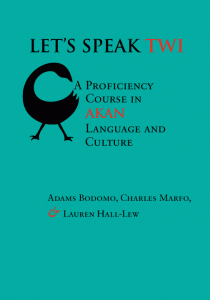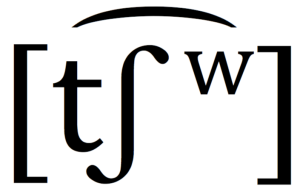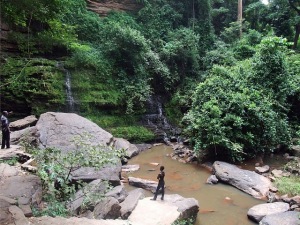An announcement
In the midst of my busiest teaching semester ever, I’m going to pause between moments of powerpoint-slide creation to advertise the final result of a project that I’m very excited about! Last month, CSLI Publications released Let’s Speak Twi: A Proficiency Course in Akan Language and Culture, co-authored by me and fellow linguists Adams Bodomo and Charles Marfo. Let me tell you a little bit about the book!
About Twi
Twi is a Ghanaian language and the most widely-spoken variety of the Akan language group. It is the politically dominant indigenous language of Ghana, particularly found in the South (although the capital, Accra, is also associated with the minority language, Ga). When Americans and Brits go to Ghana and want to learn a native language, Twi is usually the one that they study. When I talk to people who have never heard of Twi before, I often tell them that it’s the native language of Kofi Annan (remember him?).
Twi Names
The name Kofi is a very common Twi day name, given to males born on Friday. My husband’s sister, who is Ghanaian, has four children, all of them who happened to be born on Friday (!), and three of them boys. So they’re all technically named Kofi, though with variations on their name that distinguish between them (one of them goes by an English nickname, for example). I personally think Twi naming practices are really interesting… Wikipedia (and our book, of course!) gives a decent overview.
Pronunciation Tip
Here’s a hint for if you ever want to actually say the word ‘Twi’ outloud: the first sound in ‘Twi’ is a rounded affricate, so it sounds to an English speaker something like ‘chwee’. This is because the digraph ‘tw’ represents a single complex sound in Twi, not two (/t/ + /w/) as it would be in English. (As a parallel, think about how wrong it would sound if someone pronounced the th in ‘think’ as ‘tuh-hink’!)
Twi has two major dialects: Asante (or Ashanti) Twi, associated with the major city of Kumasi, and Akuapem Twi, associated with the city of Koforidua (where my husband’s family calls home). Twi is often referred to as Fante-Twi or Twi-Fante, because Fante (or Fanti or Mfantse, spoken in and around Cape Coast) is very similar to Twi; both Fante and Twi are Akan languages. But they’re different enough from one another that we decided to focus specifically on (Asante) Twi, in our book, and not on Fante. For example, here’s a website showing the differences between Twi and Fante day names.
Me & Twi
I’ve been interested in linguistic aspects of Twi for awhile, ever since meeting my now-husband, who is half-Ghanaian (and who understands Twi but doesn’t speak it so much), and his mother, to whom this book is dedicated. At the time when Jefferson and I met, I already had studied a little German, Spanish, Mandarin, and Cantonese, and as someone from Flagstaff, Arizona, I had also always been personally interested in the Navajo and Hopi languages. But Twi was so different from all of these, and as I studied it (first at Stanford University, then informally in Ghana, and then at SCALI), I grew to like it more and more.
I wrote my second of two PhD qualifying papers on a phonological issue in Twi dialect variation (with advisors Arto Anttila & Will Leben). I had considered going back to Ghana for sociolinguistic fieldwork for my dissertation. For various reasons, that never materialized, and so I’m very proud to have this book instead.
The making of “Let’s Speak Twi”
Adams Bodomo, the lead author on Let’s Speak Twi, is actually not a native speaker of Twi (he’s from Northern Ghana, and speaks a language called Dagaare). Clearly, I am not a native speaker of Twi! Our second author, Charles Marfo, is the native speaker here. The story of the book is that Adams and Charles together developed an earlier version for their students at Hong Kong University. Around the same time, I was studying Twi and was a little disappointed with the textbooks on offer. Then in 2006, Adams came to Stanford University, to collaborate with Arto Anttila. Adams showed me the earlier version and my first reaction to it was “This must get published!” So, Adams invited me to join the team and get it done.
The main challenge in getting it published was, sadly, an issue of fonts. Twi has two vowel symbols that are not part of the standard Roman script: ɛ & ɔ, which we needed in both uppercase and lowercase forms. What’s more, we wanted to represent every syllable with its own tone marking (acute or grave marking), and sometimes that symbol had to appear above the ɛ & ɔ vowels! As any linguist who’s worked with earlier versions of the SIL IPA font set will understand, these typographic features didn’t translate very well, so to speak, from Charles’ computer to my computer. After several months of hair-pulling (including the regretful purchasing of a $40 laptop that was old enough to run the right version of Microsoft Word + SIL font set, but not new to have an ethernet port or USB port to transfer the file), I decided that the only way we were going to get this text published was if I retyped the entire book. And the best thing to do was to do that in LaTeX, which I had ony just begun to learn how to use.
Most people would say that this wasn’t the smartest project to undertake in the midst of (completely unrelated) PhD dissertation fieldwork and thesis writing. It was challenging, time consuming, and a bit tedious. But in my mind, it was totally worth it! I didn’t, however, tell my advisors what I was doing (sorry John & Penny). There were months at a time when I didn’t work on the book, of course. Like most of the first half of 2009. There were many, many days when I didn’t think it would ever happen. I owe a lot of thanks to the people who helped me with LaTeX issues, namely ʻŌiwi Parker Jones and CSLI’s Emma Pease, and a huge debt of gratitude to the head of CSLI publication, Dikran Karagueuzian.
About the book
In my humble opinion, our book is really good! 🙂 It covers a wide range of levels and topics, from beginners learning the basics, to the very advanced study of things like politics and law. And it has some important, unique features. Twi is a tone language, and our book is the first to include full phonological tone information for all Twi examples. Since we’re linguists, we’ve included a chapter-length Appendix dedicated to describing the standard Twi sound system and syntactic structure, along with practice exercises for students. During my time at Oxford last year I also made an effort to render all the English parts (half of the book) so that they were both linguistically and culturally understandable for speakers of both US- and UK-based Englishes. My favorite thing in the book, though, is the list of idiomatic, colloquial, and euphemistic expressions, including taboo expressions that the learner should try to avoid, and even a few common words and phrases that can easily sound like said taboo expressions, if one is not careful! (I’m proud to say that this bit was my idea, mostly due to the trauma I face every time I need to say the word ‘eight’ in Twi…)
Purchasing
I’ll end my shameless advert here. If you’re interested in ordering our book, you can get it direct from the distributor or check it out on Amazon. Nante yie! (Go well!)






Hey, it’s already on sale at Amazon.com — with one 5 Star review!
Would like to see some sample pages in order to assess the scholatic orientaiton of the book. Do contact me (Don), at your convenience, at az_cactus_climber ‘at” hotmail “dot” com. Would like to know more.
Thanks for your inquiry! A table of contents and a sample chapter are now available at the publisher’s website: http://cslipublications.stanford.edu/site/9781575866055.shtml
Hi,
How much grammar do you have in the book? Are correct answers for the exercises provided in the book?
Thanks for your inquiry! Yes, there is a 9-page Appendix in the book that is dedicated to all aspects of grammar. Since the authors are all linguists, we paid more explicit attention to grammatical features than other Twi textbooks do. However, the correct answers for the exercises are not provided in the text book. This book is designed to be optimally used with an instructor or with advice from a native speaker. If we are able to update the book in the future we plan to include CD or dedicated website of sound files, but providing that depends on the success of the first edition. If you have any other questions, please feel free to contact me: http://www.lel.ed.ac.uk/~lhlew/contact.html
Twi language instructors are welcome to a free desk copy. Please either write me with your email address or contact CSLI Publications, directly: http://cslipublications.stanford.edu/site/contact.shtml
Pingback: Listening Back | vocalized/vocalised
A most interesting book. Are you aware of anything similar that focuses on Fante? Thanks.
Thank you. Unfortunately, no, I know of no comparable book for Fante. It is certainly needed, though (given the level of tourism in the Cape Coast region, among other things)! If you come across anything useful, I’d be interested in hearing about it. All best of luck.
I’m a native speaker of Twi(particularly Asante dialect) and Abron(a language spoken in Eastern Ivory Coast and the Brong Ahafo region). Twi isn’t hard for me seeing as both my parents speak it fluently.
Any instructors interested in an exam copy are welcome to email me directly (see ‘About the Author’ or Google my name) with your institution information and mailing address, and I will pass the information on to our publisher.